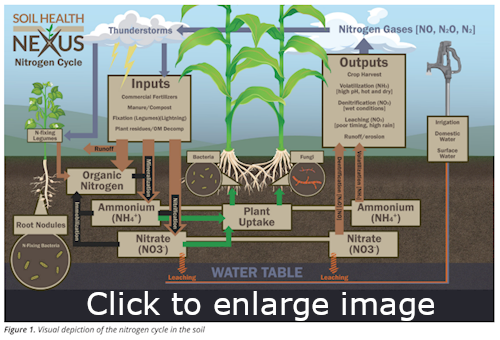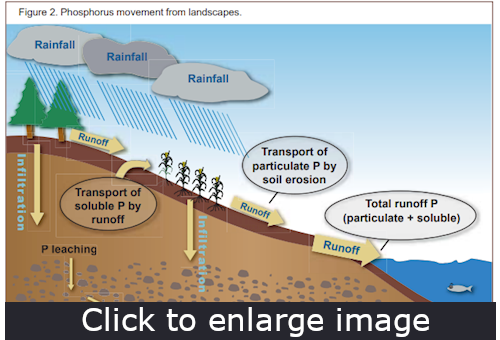
Nitrogen and phosphorus are essential nutrients for plant growth, but when they end up getting into our surface or groundwaters through runoff or leaching, they become a pollutant that can affect both human and aquatic health. Soil (sediment) that moves from farm fields, construction sites, and other landscapes during rain events further impacts our surface water ecosystems as they carry nutrients with them.
We need farmers to continue to grow food to sustain our ever-growing population. Finding ways to mitigate the movement of nitrogen, phosphorus, and sediment from leaving farm fields is key to protecting our waters for generations to come.
Nutrient applications are needed within any cropping system and are part of a larger nutrient cycle. Both nitrogen and phosphorus are applied to fields through commercial fertilizer, manure, biosolids, and other nutrient rich soil amendments. Unfortunately, due to the unpredictability of weather, the nutrient cycle is leaky. High volume rain events, rain events when the soil is already saturated, rain on frozen or snow-covered ground, and rapid snow melts can move manure and nutrients from land and into waters. Fortunately, adjustments to crop management, nutrient placement, and application timing can help mitigate the impact of unpredictable weather.

Nitrogen that is lost from a farm field through storm or subsurface runoff eventually makes its way to the Mississippi River and to the Gulf of Mexico where it contributes to the 'Dead Zone' (see 'Why it Matters'). Nitrogen that leaches down into groundwater can end up in drinking water. Though nitrogen can be removed from drinking water through reverse osmosis systems, it comes at an added cost. Rural well owners are not required to test their water quality, with this, many may not even know they are drinking water that is unsafe for consumption due to nitrogen contamination.

Once phosphorus enters our surface water, it's difficult and often impossible to remove it. Innovatively balancing crop management systems, including following the 4Rs of nutrient management, and controlling soil loss is the best way to protect our waters from nutrient pollution.
The 4Rs of nutrient management include the right fertilizer source at the right rate, at the right time and the right place.
We rely on clean water to sustain our lives and support the local economy. How soil is managed, how crops are planted, cared for, harvested, and what happens to land after a harvest, has a direct impact on our surface and groundwater resources.
Based on information from the WI DNR, approximately 20% of private wells in Dane County have shown high levels of nitrate, levels above the safe drinking water standard of 10 mg/L.
Dane County surface waters not only provide recreational opportunities to local residents, they also have a positive economic impact on the communities that surround them. Because of their great value, it is critical that we all work to protect our local water quality.
Weather events that increase runoff to our lakes and streams have become more frequent than in years past. Six of the top ten wettest years since 1869 occurred within the past sixteen years (2007-2022). Thankfully many farmers have adjusted their crop management and nutrient application systems to better withstand the increased vulnerability from rainfall, though many acres within the county still have opportunity for increased management to better mitigate impacts.
The challenges faced by Dane County farmers and landowners not only impact their communities but also communities downstream. All waters that flow through Dane County eventually end up in the Mississippi River and the Gulf of Mexico. Nutrients from runoff in Wisconsin and other states within the Mississippi River basin culminate to create a dead zone in the Gulf of Mexico, along the cost of Texas and Louisiana. A dead zone is a low-oxygen area caused by nutrient laden water which results in many acres of water that can not support aquatic life. From 2017 to 2022, the average size of the dead zone was 4,280 square miles, that's 3.5 times the size of Dane County. With the increase in heavy rain and floods in the Midwest, the problem is predicted to get worse.
All of us play a role in solving these water challenges, especially farmers and rural landowners. Many farmers and rural landowners control a large land base as compared to urban landowners; their management choices can have a big impact on local and regional water quality.
Farmers that implement innovative conservation practices have taken the lead in finding solutions to our water challenges while continuing to grow food and maintain economic viability. There are many factors that go into implementing a conservation practice. By taking steps to improve soil health, farmers are keeping their soil on the farm and our local waters clean.
Every farm is different and comes with a unique set of challenges. Through field days, farm tours, and other farmer-to-farmer learning opportunities, Dane Demo Farms strives to connect farmers to a wide array of conservation practices. Seeing a practice first-hand and hearing directly from the farmers that implement a particular practice may help farmers gain confidence in trying something new. Taking risk is a regular occurrence on a farm; farmer-to-farmer learning helps mitigate some of the risk associated with changes in crop management.